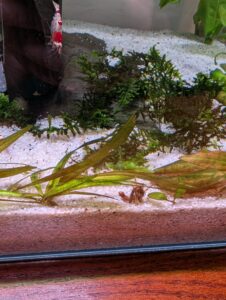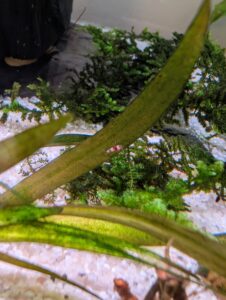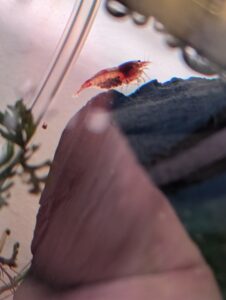
Shrimphaus has always had neocaridina shrimp and more recently after switching to low alkalinity water there are caridina shrimp too. I noticed a berried female and started a ‘baby shrimp watch’ to see what would happen.
Timing of shrimp baby hatching
The new batch of stripy caridina arrived in the Shrimphaus on 4-Sep and I noticed the berried female on 20-Oct. There is a question of whether the shrimp arrived pregnant but with this timing I suspect not. Usually in caridina shrimp with really solid colours the eggs are tricky to see, but this female has some transparency going for her and the back-lighting helps. The berried female went about her business without any dramatic change in behaviour. On 11-Nov there were multiple baby shrimp in the haus mostly all over the place, maybe 7 or 8 of them. This timing with only 3 weeks between berried female and newly hatched shrimplets is on the short side… estimates are between 20 to 40 days depending on factors such as the temperature of the water.
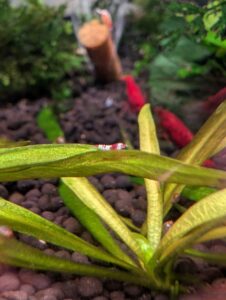
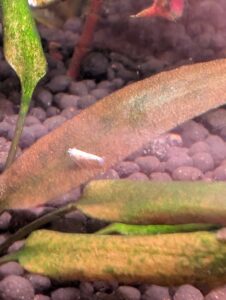
I’m pretty sure the father in question here is the last survivor of the original crop of caridina shrimp based on some pretty friendly-looking behaviour shortly after the new stripy crop of caridina arrived…This father is solid white with a pure red stripe. That gives a chance to see some interesting shrimp genetics. At first glance it seems like about half of the shrimplets are more of the solid white type and half are more striped. Maybe that reflects the relative contributions of the mother and father?
Shrimplets go into hiding
Although the new baby shrimp were pretty easy to see that first day they subsequently went into hiding. For a while I was wondering whether they had been eaten by the adults, but apparently that doesn’t happen. I suppose it makes sense for a young shrimp to try to avoid being out in the open more than necessary. These are mostly white and the background in the shrimphaus is mostly dark but even so finding them is tricky.
prominent red stripe on this baby caridina shrimp
nearly all-white baby caridina shrimp
Hard water with low pH seems ok for caridina shrimp breeding
The Shrimphaus has an unusual water profile. Starting off with Cambridgeshire tap water that has high levels of calcium carbonate, I remove the carbonate by adding hydrochloric acid. The result is a low alkalinity (KH – carbonates) yet high hardness (GH – calcium/magnesium) environment. Since pH tracks with KH, the pH is also low. The usual type of recommendation for caridina water parameters is to keep KH as low as possible. I agree with this – I’m aiming for an alkalinity of 15 ppm so a KH of about 0.8. For recommended GH levels “as low as possible” doesn’t work for either caridina or neocaridina shrimp since they need some calcium for proper shell development and moulting. A GH of between 4 and 6 seems pretty common. The GH in the Shrimphaus is much higher, more like 17 or 18. General opinion is a GH that is “too high” is bad, but having caridina shrimp breed successfully is a pretty good test of whether the water conditions are ok for them and I suspect having low KH and high GH is something that has mostly just gone unstudied.
Total dissolved solids are also high
Because there are so many conductive ions the Shrimphaus also has high levels of “total dissolved solids” – around 380 ppm. Total dissolved solids (TDS) is a bit of a misnomer since what people inevitably measure is electrical conductivity. I have never really understood the point of measuring TDS. I suspect this is more of a “because we can measure it” thing and a not very good proxy for measuring KH and GH.
Neocaridina vs caridina survival and breeding
Neocaridina shrimp survive just fine in Cambridgeshire tap water, but that doesn’t necessarily translate into breeding well. The bloody mary neocaridina shrimp had a couple of generations of baby shrimp, but thereafter pretty much stopped breeding. Caridina shrimp don’t really even survive in direct-from-the-tap Cambridgeshire water, but do survive if the alkalinity has been removed by carefully calibrated acid treatment. Now it seems the caridinas can breed as well. Whether this is a one-off or not we’ll have to wait and see.
Update: not a one-off!
Here we are at the end of January and there are two more berried caridina females and today the first sighting of a new baby! Looks like the water parameters are working for the caridina. I also did a rescape very recently and included some new piles of rocks – apparently that’s good for shrimp breeding.
